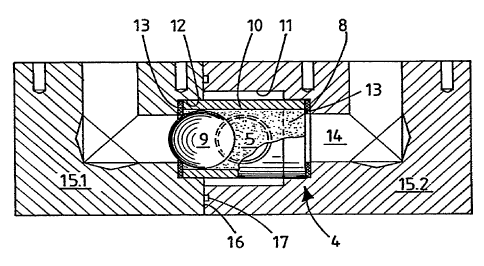Une partie des informations de ce site Web a été fournie par des sources externes. Le gouvernement du Canada n'assume aucune responsabilité concernant la précision, l'actualité ou la fiabilité des informations fournies par les sources externes. Les utilisateurs qui désirent employer cette information devraient consulter directement la source des informations. Le contenu fourni par les sources externes n'est pas assujetti aux exigences sur les langues officielles, la protection des renseignements personnels et l'accessibilité.
L'apparition de différences dans le texte et l'image des Revendications et de l'Abrégé dépend du moment auquel le document est publié. Les textes des Revendications et de l'Abrégé sont affichés :
| (12) Brevet: | (11) CA 2221272 |
|---|---|
| (54) Titre français: | FILTRE DOUBLE POUR L'AIR COMPRIME |
| (54) Titre anglais: | A TWIN FILTER FOR COMPRESSED AIR |
| Statut: | Réputé périmé |
| (51) Classification internationale des brevets (CIB): |
|
|---|---|
| (72) Inventeurs : |
|
| (73) Titulaires : |
|
| (71) Demandeurs : |
|
| (74) Agent: | GOWLING WLG (CANADA) LLP |
| (74) Co-agent: | |
| (45) Délivré: | 2006-07-25 |
| (86) Date de dépôt PCT: | 1996-05-28 |
| (87) Mise à la disponibilité du public: | 1996-12-12 |
| Requête d'examen: | 2003-05-20 |
| Licence disponible: | S.O. |
| (25) Langue des documents déposés: | Anglais |
| Traité de coopération en matière de brevets (PCT): | Oui |
|---|---|
| (86) Numéro de la demande PCT: | PCT/FI1996/000300 |
| (87) Numéro de publication internationale PCT: | WO1996/039240 |
| (85) Entrée nationale: | 1997-11-14 |
| (30) Données de priorité de la demande: | ||||||
|---|---|---|---|---|---|---|
|
L'invention porte sur un filtre double pour l'air comprimé, dans lequel il y a deux filtres (3) placés en parallèle et un système de valves (2, 4) pour diriger l'air comprimé vers un filtre choisi (3). Ce système de valves comprend des valves d'entrée (2) pour diriger l'air comprimé depuis l'entrée (1) vers le filtre choisi (3) et un système de contre-valves (4) pour diriger l'air comprimé du filtre choisi vers la sortie d'air comprimé choisie (5.1). Le système de contre-valves comprend une chambre (8) à bille formée dans la structure du logement, avec des conduits d'entrée (14) aux extrémités et un conduit de sortie (5) au centre. Une bille (9) est prévue pour fermer le conduit d'entrée (14) sur lequel il n'y a pas de pression. La chambre à bille comprend un élément filtrant (10) d'un type connu et dans la zone centrale duquel se trouve un canal de sortie (annulaire) qui reçoit le flux de sortie allant vers le conduit de sortie (5).
The object of the invention is a twin filter for compressed air, in which
there are two filters (3) set in parallel and an arrangement
of valves (2, 4) to direct compressed air through a selected filter (3), which
arrangement of valves includes inlet valves (2) to distribute
compressed air from the inlet (1) to the selected filter (3) and an
arrangement of counter-valves (4) to direct the compressed air from the
selected filter to the compressed air outlet (5.1). The arrangement of counter-
valves includes a ball chamber (8) formed in the housing
structure, at the ends of which are inlet connections (14) and an outlet
connection (5) in the centre. A ball (9) is arranged to close that inlet
connection (14) in which there is no pressure. The ball chamber consists of a
filter element (10) that is, as such, known, in the central area
of which a ring-like outlet channel (11) is formed, which collects the outlet
flow to the outlet connection (5).
Note : Les revendications sont présentées dans la langue officielle dans laquelle elles ont été soumises.
Note : Les descriptions sont présentées dans la langue officielle dans laquelle elles ont été soumises.

Pour une meilleure compréhension de l'état de la demande ou brevet qui figure sur cette page, la rubrique Mise en garde , et les descriptions de Brevet , États administratifs , Taxes périodiques et Historique des paiements devraient être consultées.
| Titre | Date |
|---|---|
| Date de délivrance prévu | 2006-07-25 |
| (86) Date de dépôt PCT | 1996-05-28 |
| (87) Date de publication PCT | 1996-12-12 |
| (85) Entrée nationale | 1997-11-14 |
| Requête d'examen | 2003-05-20 |
| (45) Délivré | 2006-07-25 |
| Réputé périmé | 2011-05-30 |
Il n'y a pas d'historique d'abandonnement
Les titulaires actuels et antérieures au dossier sont affichés en ordre alphabétique.
| Titulaires actuels au dossier |
|---|
| JAUHOLA, LAURI |
| Titulaires antérieures au dossier |
|---|
| NIKKILA, TERO |